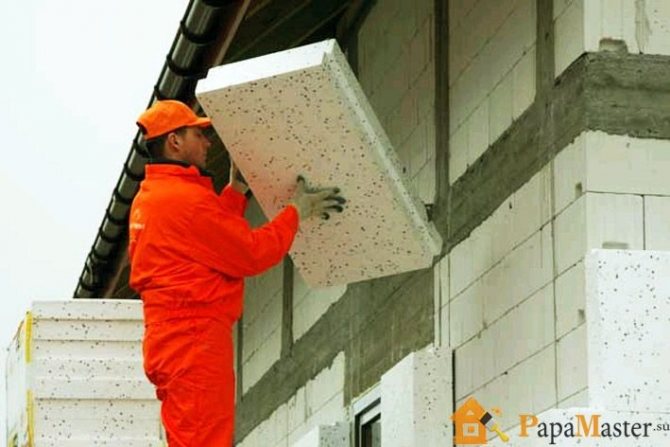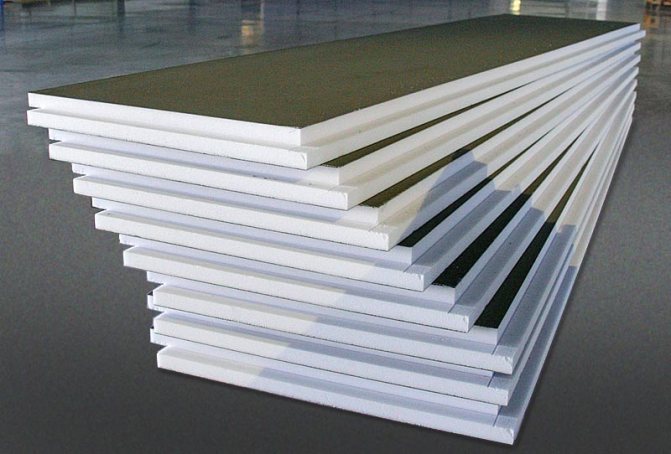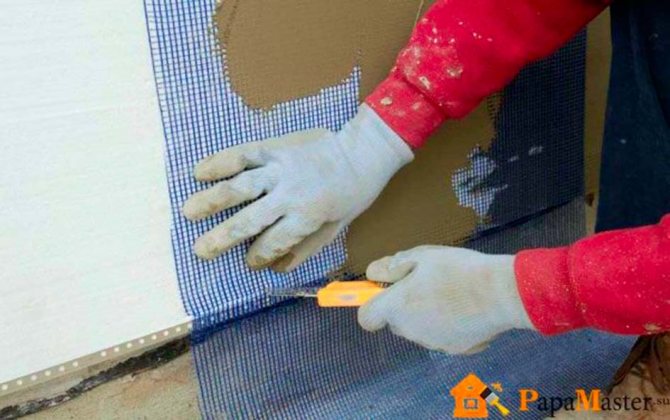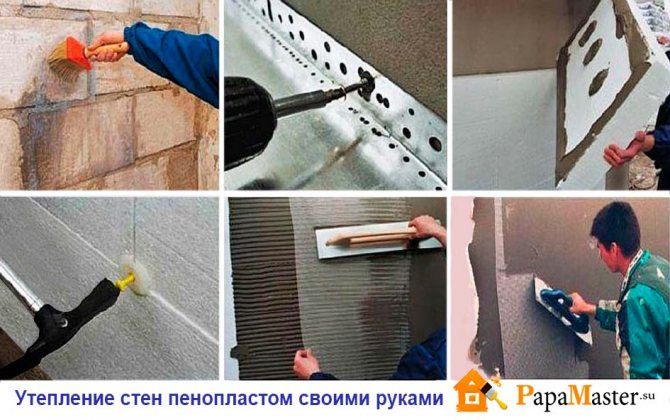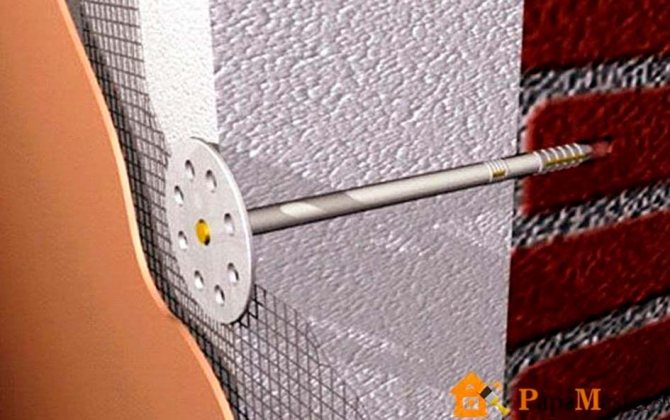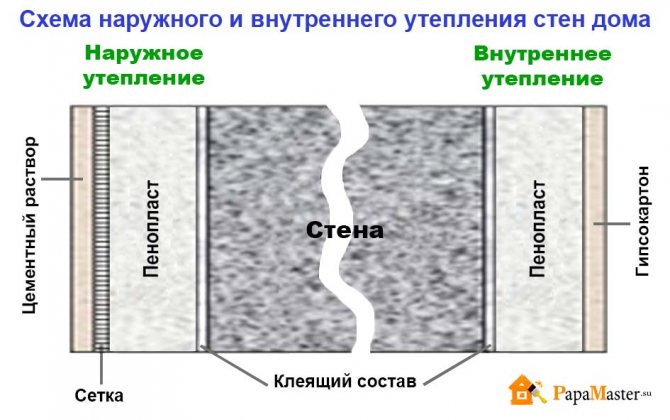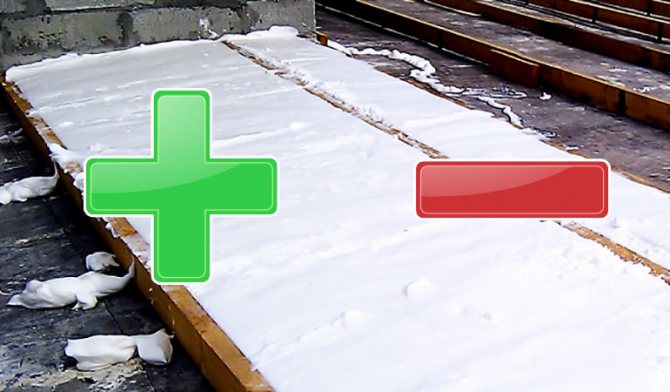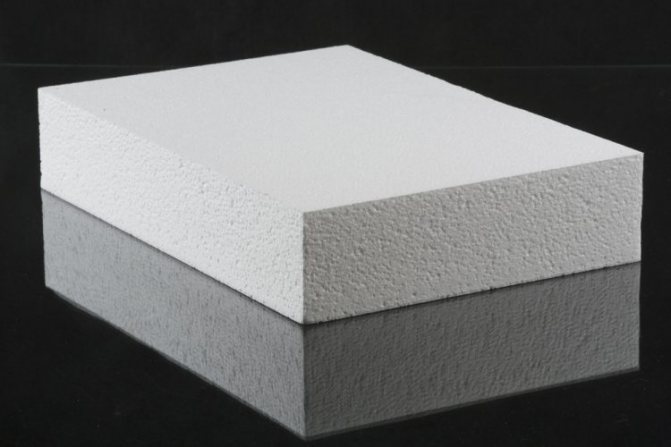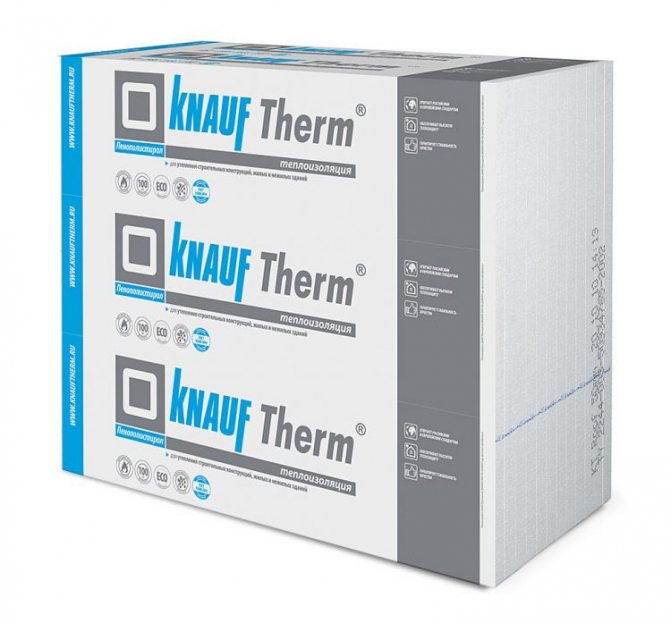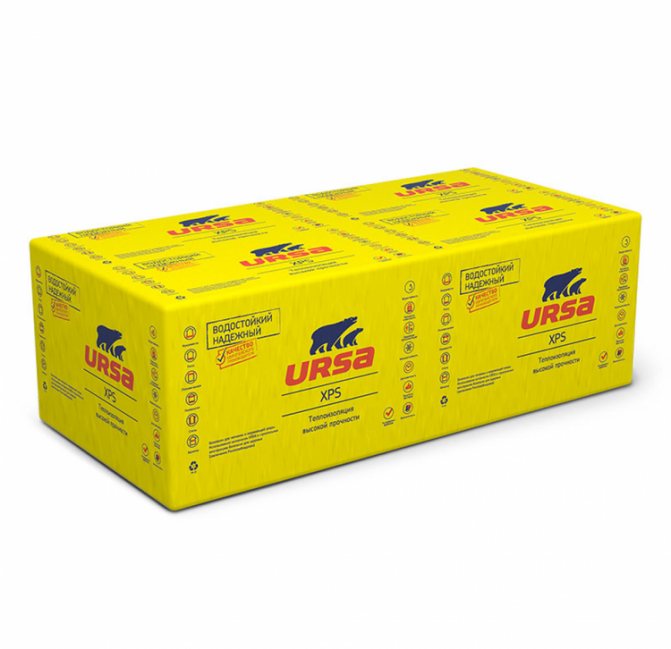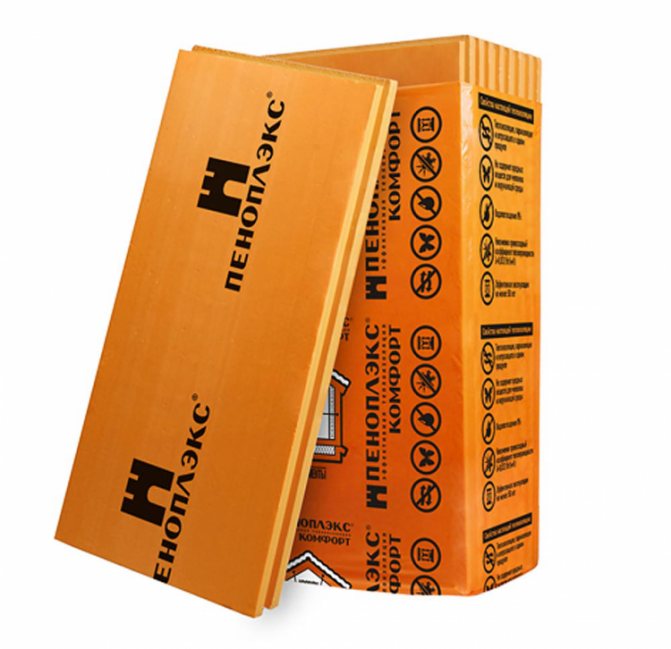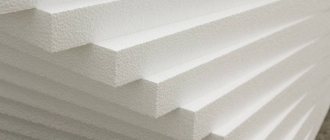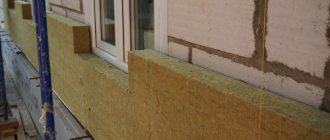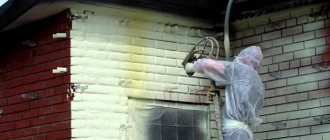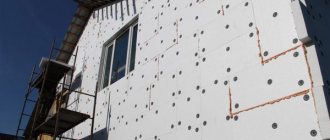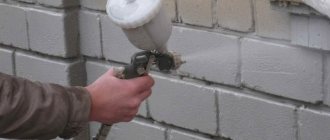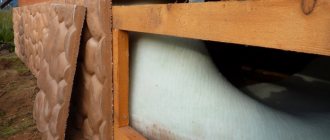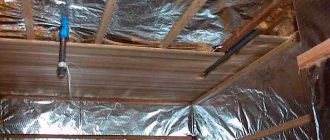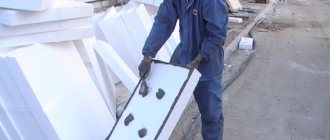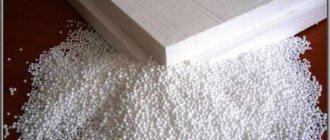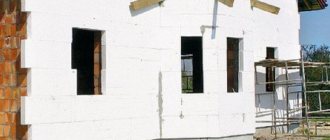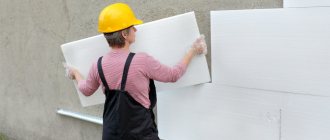Styrofoam characteristics
Before using expanded polystyrene for facade insulation, you need to choose it correctly. Polyfoam used as thermal insulation must necessarily contain flame retardants - substances that prevent it from burning.
Their presence is indicated by the letter "C" in the abbreviation (PSB-S) or the letter "R" if the material is of foreign production. Indicators such as density and thickness are equally important. For insulation of residential buildings outside, plates of five centimeters wide are usually used, no more.
Depending on the type of foam, its density can vary from 15 to 35 units. And since foam is a fairly warm material, its density should not be very high. To insulate the walls of a house, it is enough to take insulation with a compression density of 15 or 25 units. Density 35 is used for floor insulation.
In addition to density, the following qualities and characteristics are characteristic of foam:
Types of expanded polystyrene
Polystyrene foam is classified according to the method of production of the material and the inclusion of various additives in it:
- pressed expanded polystyrene
... Produced by pressing; - pressless expanded polystyrene
... Produced by removing moisture by drying and then foaming at high temperatures; - Not much different from the pressless one, an extruder is additionally used in production. The best and best option for wall insulation.
There are other types of expanded polystyrene (extrusion, autoclave), but they are not used as insulation, because they have different characteristics.
In addition to the types of expanded polystyrene, there are also various types of insulation, such as:
Insulation of a brick wall with foam
You can insulate the walls with foam plastic both inside and outside. However, most often the insulation of a brick wall is carried out outside. External thermal insulation allows you to shift the point of greatest freezing, which prevents the penetration of cold into the house. The walls of the house must be warmed up by internal heating. When installing the foam from the inside, the brick wall will be isolated from the inside, which will interfere with its heating.
As a result, the dew point will shift between the wall and the expanded polystyrene. Moisture will begin to accumulate on the inner surface of the walls under the insulation, soaking the walls and freezing in frosts. As a result, all this will lead not only to freezing of the house, but also to the rapid destruction of the insulation and the brick wall itself.
Therefore, it is advisable to fix the foam insulation slabs on the outside of the façade. But in this case, it is necessary to cover it with a layer of plaster without fail, this will protect the material from the sun's rays, thereby extending its service life, and will also give the structure the necessary strength.
Wall cake when using insulation - expanded polystyrene outside
Pie walls are layers of materials that are stacked in a specific order, each of which performs its own functions to ensure a normal indoor climate.
When thermal insulation of brick walls with polystyrene laid outside, the wall cake looks like this:
- internal plaster;
- outer wall;
- adhesive solution for gluing polystyrene foam;
- insulation (expanded polystyrene);
- adhesive solution for gluing the next layer;
- fiberglass mesh;
- adhesive composition;
- primer;
- finishing plaster.
NOTE!
When arranging a wall using expanded polystyrene, it is necessary to lay the layers in a strict sequence.
Internal and finishing plaster can be replaced with other finishing materials, which are provided by design solutions.
Wet wall cake
Pros and cons of foam insulation of a wooden house
The question is often asked: "Is it possible to insulate the walls of a wooden house with foam plastic?"
... Among experts, one can find two opposite opinions on this score: some argue that it is possible, others are categorically against it. Let's try to figure it out.
One of the reasons why many speak out against the insulation of a wooden facade with foam is its low vapor permeability, due to which the wood can rot. At the same time, there are many people who risked insulating their wooden house with this material, and are satisfied with the result.
One of the main advantages of wood is its ability to "breathe". This is one of the main advantages of the construction of a suburban wooden house. In order not to lose this quality, the thermal insulation of the facade should be carried out with care. The consequence of improper insulation can be not only insufficient air flow into the room.
Correct insulation technology implies that the vapor permeability of building materials should increase towards the street, so as not to impede the escape of fumes from the house.
If this rule is violated, moisture will condense on a denser material, which will lead to wetting of the insulation, the formation of condensation and, as a result, wood rot. That is why, when choosing a heater for your wooden facade, pay attention to the vapor permeability of building materials.
As can be seen from the table, the vapor permeability indicators of expanded polystyrene are much lower than those of the walls of a wooden house. Hence, we can conclude that it is undesirable to warm wood with foam, unless you find this material with a higher vapor permeability.
And what does practice tell us? Many people, despite the recommendations or simply not knowing about them, insulate wooden facades with foam and are quite satisfied. The question arises, where does the condensate go.
It should be noted here that the rate of decay directly depends on the amount of moisture evaporating from the house. If the room is equipped with a good ventilation system, then the harm from a small amount of vapors, of course, will be less. However, if you insulate a wooden bath with foam plastic, the result will be obvious within the next few years.
The main reason why polystyrene as insulation is so demanded in recent years is its low cost. That is why, in an effort to save money, many decide to insulate wooden buildings with this material.
Over time, however, these savings can become ruinous. Alternatively, it is better to choose mineral wool. It does not create obstacles in the way of fumes, which perfectly reach the ventilation gap between the insulation and the cladding. The walls "breathe", and you can enjoy life in your wooden house.
The main advantages of the material
In fact, polystyrene is the same plastic, only endowed with different qualities. But due to the fact that it is somewhat lighter and less dense, it does not cease to be just plastic, and therefore all the advantages of this material are inherent in it.
Plus, polystyrene is resistant to most chemicals.
In this case, a layer of concrete is formed over a layer of expanded polystyrene, which, in turn, rests on a cushion of sand and gravel.
The concrete floor screed is also erected on top of evenly laid EPS boards.
The blind area, insulated with expanded polystyrene, will help protect the upper part of the foundation from freezing. Plus, an interlayer of such material will work as an additional water-repellent layer.
Since the density of extruded polystyrene foam is an order of magnitude higher than that of conventional polystyrene, a number of small problems arise with this. For example, this type of material can still be cut with a knife, but, firstly, its blade must be extremely thin and strong, since a thick blade can lead to discoloration and cracks in the board.
And secondly, the creak and rattle that will accompany such an "event" will be an order of magnitude higher than in the case of conventional expanded polystyrene. Therefore, before starting the procedure, it is recommended to lubricate the knife blade with machine oil.
Some people use a grinder equipped with the thinnest metal wheel for cutting EPSP blocks. Cutting, in this case, is effective, but the whistle is such that it is better to insert plugs into the ears. Among other things, this method is the most "unclean". After it, a huge amount of garbage will remain.
If you decide to use a grinder for cutting expanded polystyrene, we recommend that you familiarize yourself with this equipment.
A machine or machine for cutting polystyrene foam can be easily made with your own hands. To do this, you just need to get some nichrome and a powerful transformer. By connecting the opposite ends of the nichrome wire to the wires coming from the power source, we get a kind of polystyrene foam knife. And in order for the cut to be the most even, the nichrome wire in the device should be kept taut
The glow-wire cutting method is considered the most effective and simplest. Two nails are taken, between which a wire of nichrome is stretched. Voltage is applied to the nails through a transformer, the wire is heated and the process has begun. Using this method, you can cut the most accurate blocks and shapes of a high degree of complexity.
But this method is also the most harmful. As already mentioned, the vapors of phenols released during the cutting process can cause significant harm to the human body, and therefore, this procedure should be carried out in the open air, preferably in a draft or using a special respirator, or even a gas mask.
Few people know, but an excellent formwork for foundations comes out of expanded polystyrene. The material lends itself perfectly to cutting, drilling, etc., and therefore anyone, having shown a certain amount of ingenuity and resourcefulness, is able to make a wonderful insulated foundation for their structure
Fire safety measures
When working with extruded polystyrene foam, you should adhere to strict fire safety measures, otherwise it will be much more difficult to extinguish the flared material than it seems.
That is why, in case work is carried out with the use of open fire nearby, for example, there is a furnace with which bitumen is melted, etc., you should always have a hose with water supply, a fire extinguisher or, at worst, a barrel of water and a bucket ready. ...
The same is advised to do when welding in the immediate vicinity of the EPS. Moreover, here it is advised to either block the material from sparks and scale flying from welding, or pre-wet the nearby polystyrene plates with water, it is better to do both at the same time. Only in this case will you protect yourself and your building from fire.
Most fire hazardous situations at a construction site occur precisely because of neglect of precautions. If welding work is carried out in the vicinity of work performed with the use of rapidly flammable materials, always expect trouble. And to prevent this trouble from happening, you should always keep at hand, at least, a fire extinguisher
Thermal insulation with liquid foam
There is another way of insulation - the use of polystyrene foam in liquid form. This type of filling foam is made directly at the construction site and poured into a pre-prepared formwork.Liquid foam can be used to insulate a brick, stone and concrete house.
Thermal insulation technology called "well" masonry is well suited for this material. It provides for a three-layer structure: wall, insulation, additional brickwork. In this case, the insulation is pumped between the two layers.
The advantages of liquid foam include:
- High quality material.
Filling polystyrene foam does not allow cold in winter and heat in summer; - Low price.
Liquid foam saves on stacking and shipping costs. According to experts, wall insulation using this material is almost half the price compared to other insulation materials; - Practicality.
Pouring liquid foam is several times faster than installing conventional insulation. And the principle of pumping thermal insulation allows you to implement new unusual solutions.
Despite the emergence of more and more insulation materials, foam continues to be popular among professional builders and DIYers. What allows this material to maintain its leading position as insulation, and what are the ways to use it?
Vapor barrier and waterproofing issues
An important requirement in the construction and arrangement of a house is the correct execution of all work to ensure ventilation and waterproofing, since it is the incorrect installation of these components that significantly reduces the characteristics of the structure.
When walls are insulated with polystyrene, waterproofing is not needed
... It should be noted that with a high passage of groundwater under the building, it is imperative to waterproof the basement and foundation.
Since expanded polystyrene does not allow air and water to pass through, there is no need to lay the vapor barrier layer when insulating the walls from the outside.
Insulation wall cake for siding
Characteristics
Foam production was started more than eighty years ago. The first block was produced in Germany, after which it began to be used everywhere in various territories. Polystyrene balls serve as the basis for the insulation boards. Initially, they are elements with a dense structure that do not even remotely resemble foam. At the first stage of production, they are foamed. Next, the base is dried and aged, which is subsequently immersed in a special chamber, where it is sintered with steam at a certain pressure. In the pre-sale phase, the foam is in large blocks that are cut to specification.
The size of a standard sheet that is used for insulation has a length and width of one meter, there are also options for a foam sheet with a half-width smaller. The most popular sheet size is 120 by 60 cm.The difference in types lies not only in size, but also in the density of the material. A density of 25 kg per cubic meter is considered normal for facade insulation. Plates with a density of 15 and 40 kilograms are also produced. This indicator directly affects thermal conductivity. The higher the number, the lower the thermal conductivity and the higher the price for the foam. A denser insulation can withstand heavy loads, so it is often used to insulate the floor.
Due to the fact that the balls undergo preliminary foaming, this saturates them with gas, which determines the low thermal conductivity of the foam. Its indicator is in the range of 0.038 W / (m × K). Typically, the foam is produced in white, but in the process of making polystyrene beads, the manufacturer can add any pigment required to make his products stand out from other options. In some cases, extruded polystyrene foam and expanded polyethylene can also be called foam. These materials differ from polystyrene in the manufacturing method and the underlying material.
Properties
Based on the characteristics and experience of using foam, it is quite easy to highlight its strengths and weaknesses. The advantages of such an insulator include:
- minimum weight;
- ecological cleanliness;
- low cost;
- the possibility of self-assembly;
- the possibility of insulating various surfaces;
- ease of processing and fitting;
- resistance to biological processes;
- soundproofing properties.
The solids in the foam are only a few percent compared to the total volume of gas contained in the material. This makes it lightweight. Thanks to this, the insulation is perfect for use with frame structures, since it does not exert significant pressure on the foundation and walls. This feature also simplifies the process of lifting the material to a height and self-assembly. Polystyrene is a polymer that, in its structure and composition, does not cause any harm to human health and the environment, if you do not eat it, so you can insulate the structure with foam without fear that harmful substances will start to be released from heating over time. The comparative cost of such a material is low, so it is suitable for low-budget insulation of temporary buildings.
The installation of the material does not cause any particular difficulties, therefore it can be carried out without assistance. Due to its versatility, insulation can be made for any available surface. At the same time, the foam does not react with most building materials, if you do not take into account organic solvents. Therefore, when laying foam on wooden, brick or concrete surfaces, there are no problems. The insulation can be processed with an ordinary knife or hacksaw, which simplifies the process of adjusting it to various shapes. The material of small thickness can take curvilinear shapes, therefore, insulation of semicircular bay windows is available. Polyfoam is an excellent insulation for the basement and foundation. This is due to the fact that it can be in the ground for many years without changing its properties, since it is not subject to decay processes and mold and fungus do not develop on the surface of the foam. The wall insulated with foam acquires additional soundproofing properties, which is also a positive effect.
It is also important to know about the disadvantages, which, however, are covered by the existing advantages:
- instability to organic solvents;
- low mechanical strength;
- fire hazard;
- lack of vapor permeability.
It is not recommended to use insulation during painting. Certain types of paints that are diluted with solvents can damage the material by decomposing it. A surface insulated with foam requires additional reinforcement by installing a fiberglass mesh in order to increase its strength, since even a slight mechanical effect can leave a dent in the material. Although fire retardants are added to the insulation during production, this does not make it absolutely fireproof. When exposed to high temperatures, the material melts with the release of carbon dioxide, but is capable of self-extinguishing. Due to the density of the material, air does not pass through it, which provides insulation from moisture, but creates a barrier during its outflow, which can result in the formation of mold under the insulation.
Note! Rodents can get inside the insulation slabs. Mice and rats do not eat it, but simply make passages inside, arranging a dwelling. Poultry also loves to peck on styrofoam, damaging its integrity.
Advantages and disadvantages of expanded polystyrene
Expanded polystyrene material is a porous air-containing raw material
, is used in most cases as a heat-insulating material.
In industry, the material can also be used as electrical insulation and packaging material.
The material has gained widespread use due to its quality indicators:
- low level of water absorption;
- low thermal conductivity;
- ease;
- biological resistance;
- durability;
- compressive strength;
- not affected by temperatures;
- ease of installation;
- low price of the material.
Comparison of heaters
Despite an impressive list of positive indicators, expanded polystyrene has disadvantages that must be taken into account during installation:
- low rate of sound insulation;
- instability to solvents and many chemicals;
- afraid of fire. When burning, it releases harmful toxic substances;
- poor resistance to ultraviolet light;
- easily lends itself to the influence of rodents and insects, which, making holes in the material, provoke its destruction;
- low vapor permeability;
- fragility.
However, the production technology of these materials is different.
: expanded polystyrene is produced by extrusion, when granules melt when combined into a single structure, foam - by gluing granules with dry steam.
Specifications
Is it worth it to insulate from the inside
The question of insulating a house or other building with foam from the inside causes a lot of controversy, since it is difficult to unequivocally answer this question. It is worth saying that this method of foam insulation exists, but it also has opponents. The main argument is that heat-absorbing materials should be placed inside the room, since they absorb the ambient temperature, and the heat-insulating materials should be left outside so that they prevent the penetration of cold to the building materials. Insulation from the inside with foam is possible if you provide high-quality ventilation of the room, which will remove moisture in a timely manner, which will prevent the formation of mold. It is also important to calculate everything correctly so that the dew point does not shift towards the dwelling. In this case, due to the difference in air temperatures inside and outside, condensation will occur between the insulation and the wall, which will lead to the destruction of the blocks. A video of the process of internal foam insulation is below.
Pros and cons. An increasing number of homeowners, frightened by the bills for heating fluids, decide to insulate their homes and choose polystyrene as a heat insulator.
- the pros and cons, how not to make a mistake in the choice, the article is devoted to these issues.
We stipulate right away: polystyrene and expanded polystyrene are produced from the same raw materials, but these are different materials. Polyfoam is a brittle, flammable, light-degradable material that does not withstand mechanical stress and is intended for packaging. For insulation, polystyrene foam is used - a denser material with completely different characteristics, but in common parlance, both materials are called the same, which often leads to confusion.
The production process of foamed organic styrene is a technical development in 1951 of the American concern BASF. The insulation, called "styrofoam", consisted of 98% of air filling the cellular foam base. The material was characterized by low thermal conductivity, low water absorption and vapor permeability.
As a result of the improvement of technology, extruded polystyrene foam appeared - self-extinguishing foam. Their main difference lies in the structure of the cells: for expanded polystyrene, the structure is open, for extruded material it is closed, due to which water absorption decreases and fire resistance increases.
The quality and technical characteristics of foamed plastics in Russia are declared by GOST 15588-2014 “Foamed polystyrene heat-insulating plates. Technical conditions ". For wall insulation in a system with an outer plaster layer, in accordance with this document, it is necessary to use expanded polystyrene with the F marking - facade.
The letter G in the marking of the plates indicates the content of graphite in the composition, which gives a lower thermal conductivity and paints the material in the mass in a silvery-black color.
We're for it"!
So say people who have recently performed foam insulation at home. Indeed, the material has a lot of positive qualities:
- Low weight.
- Low thermal conductivity.
- Excellent sound absorption performance.
- Self-extinguishing property.
- Ease of use.
- Low cost.
Yes, indeed, in terms of thermal conductivity, foam is second only to polyurethane foam, the volumetric weight of the slabs is from 10 to 50 kg per 1 m3, while in the best materials made of mineral wool it starts from 30–35 kg / m3, it perfectly dampens noise and fades in 1 second, and any homeowner can work with it.
And we are against
This is what people say who insulated the house without taking into account the specifics of the material. Let's list the negative qualities of the material:
- Low vapor permeability.
- Great water absorption.
- Low resistance to mechanical damage.
- Light instability.
- Rodents love.
Due to the low vapor permeability of this material, it is undesirable to insulate the outside of the house from wood - without the device of two ventilated gaps, which is difficult and busy. Moisture absorption of 4% with low quality of work will ensure wetting and loss of heat-insulating qualities by the material after 2 seasons.
When insulating as part of a light plastering system, any accidental blow can lead to the destruction of the protective layer, and the exposed foam will simply crumble under the influence of sunlight. And finally, the last: this material is preferred by mice for making nests in the thickness of the insulation - it is warm, it is easy to gnaw through the passages.
In wet plaster systems, a metal perforated corner - the starting profile - saves from the invasion of rodents, but when installing a ventilation facade, they easily overcome this obstacle.
Where to use Styrofoam?
So why, despite all the negative qualities, polystyrene foam is popular? How to use the best qualities of the material to make your home comfortable and minimize the negative?
Let's consider. A little heat engineering in the tape: for the insulation system to work, it is necessary that the vapor permeability of materials increases from the inside out, and the thermal conductivity of materials, on the contrary, decreases.
That is, the material from the street side should have a higher vapor permeability than the internal material and a lower coefficient of resistance to heat transfer.
Comparing the heat transfer resistance of building materials and foam, we see that this indicator satisfies the requirement, but when comparing the vapor permeability, it turns out that in the case of wood, the foam polystyrene index is lower than that of wood, which means that the dew point will be on the wooden structure, which will lead to the deposition of condensate on it, getting wet and rotting.
When insulating a house made of wood with foam from the inside, the requirement is also not met, since the coefficient of heat transfer resistance of wood is greater than that of insulation.
conclusions
Polyfoam is not suitable for insulating wooden houses, but it will perfectly cope with the task of keeping warm with walls made of bricks or light aerated concrete. When choosing an insulation system, it is better to stay on a wet (plaster) system if the house is located near cultivated areas, where vole mice are a common occurrence.
Considering all of the above and exactly following the instructions of the manufacturers when performing the work, the use of foam for insulation is justified and will last longer than the guaranteed 50 years.
Building materials cannot cope with the task of creating a favorable microclimate in the room, therefore, in construction they cannot do without additional insulation. Builders often use foam as insulation for the roof, ceiling, attic floor, as well as for the foundation and walls.The material has different technical characteristics in terms of thermal conductivity and thickness, which can be used in accordance with the installation site and needs. Another plus is the simplicity of panel cutting and installation.
Polyfoam, or expanded polystyrene, is a cellular mass made of foamed plastic. The characteristic lightness of the material is due to the fact that its main volume consists not of the initial polymer, but of air, which, moreover, is a poor heat conductor.
Marking and density of expanded polystyrene
If the letter C (PSB-C) is added to the marking of the abbreviation in accordance with GOST-15588-86, this indicates that fire retardants have been added to the foam polymer and such foam belongs to the flammability group G1 or G2. If this letter is absent, then there are no fire retardants and this is G3 or G4. The density of the material shown in the table means the following:
- PSB-S-15 - the number indicates that the panel density is not 15 kg / m 3, but up to this mark. This is the lowest indicator among all brands, therefore PSB-S-15 is used in places that do not bear mechanical stress: insulation of roofs, ceilings, as well as walls and floors under frame cladding. This brand is also used for soundproofing rooms.
- PSB-S-25 - density up to 25 kg / m 3, and such panels have a universal nature of use - they are used more often than other materials. In addition to places that do not bear a mechanical load, this insulation is used for building facades with the application of ordinary and decorative plasters to it.
- PSB-S-35 - panels density up to 35 kg / m 3 allows their use in sandwich panels, in reinforced concrete structures (fixed formwork), as well as for the arrangement of waterproofing. This brand is also used for underground work - insulation and waterproofing of basements and foundations.
- PSB-S-50 is the most durable polystyrene foam and can be used both for places with low mechanical stress and high. It can be used to insulate floors, heated soils and even autobahns.
Operational and technical characteristics
Thermal conductivity diagram of building materials
The most basic quality of expanded polystyrene is low thermal conductivity, this property of foam as a heater in comparison with other building materials is shown in the table above. The effect is achieved due to the uniform distribution of air in the volume of the foamed polymer and its thickness. PSB of any density can be used for indoor and outdoor work with any degree of humidity, as well as with temperature drops (range is from -200ᵒC to + 85ᵒC).
In addition to insulation, expanded polystyrene is used for sound insulation of certain objects, for example, PSB is laid inside plasterboard partitions or under the metal roof of a building. Polyfoam is a chemically neutral substance and has a long service life. Even when a leak is observed, for example, when the roofing material is damaged (corrugated board, slate, etc.), the properties of PSB are not lost, since there is no reaction to moisture.
Styrofoam of different thickness
Foam panels are resistant to weak acids, alkalis and alcohol, which greatly increases the range of applications. PSB is easy to cut and at the same time you can use the simplest tools - a painting knife or a hot string of nichrome. Installation is carried out on glue, on umbrella dowels or between profiles.
Foam technology for thermal insulation
The ease of cutting polystyrene, the ease of its installation and low cost contributes to the popularity of the material for private construction. With competent calculations and correct laying of foam plates, it is possible to ensure a normal microclimate in residential and non-residential (household buildings, attics, and so on) premises.
Which side is it better to install the foam
Dew point displacement depending on the location or lack of thermal insulation
When insulating a building, including the attic, the location of the insulation is of great importance, since this shifts the dew point and the effectiveness of the insulating material. If the slab is installed indoors, the wall still remains cold, therefore, it is necessary to increase the thickness of the expanded polystyrene. In addition, the dew point (condensation) most often occurs at the point where the foam meets the wall, which leads to the formation of mold.
If the insulation is mounted outside, then the dew point is shifted to the foam and condensation is not collected due to the lack of moisture inside the foam polymer. In this case, the wall heats up from the side of the room and dampness does not get there, therefore, the operational resource increases. If thermal insulation occurs under the roofing material, then it is only internal and condensation cannot form at the junction - the dew point is transferred into the attic.
Calculation of the thickness of the foam insulation
The ratio of the coefficient of thermal conductivity and the required thickness of the material. (* Indicates the addition of a factor of 1.15 for buildings with monolithic belts of heavy concrete)
According to SNiP 2.09.84.87-2001, the table shows the minimum coefficient for residential and office buildings. In addition, for each region there is a certain value of thermal resistance - this is a constant value, which is denoted by the letter R. For an indicative calculation, you can take the average indicator R = 2.8 (m2 * K / W).
The calculation formula looks like this: R = R1 + R2
, where R1 is a wall (conditionally brickwork), R2 is a heater (conditionally foam).
The total and individual thickness of materials is calculated by the formula R = p / k
, where p is the layer thickness in meters, k is the thermal coefficient of the building material (W / m * k). For an indicative calculation, a masonry of two bricks and PSB-S-25 foam plastic will be used.
Building insulation with expanded polystyrene
The length of an ordinary brick (coefficient 0.76 (W / m * k)) is 0.25 m, which means that the masonry has a thickness of p = 0.25 * 2 + 0.01 = 0.51 m.The total thermal conductivity of the brickwork will be Rbrick = p / k = 0.51 / 0.76 = 0.67 (m2 * K / W). Therefore, Rfoam = Rtotal-Rbrick = 2.8-0.67 = 2.13 (m 2 * K / W).
For the total thickness of expanded polystyrene, you need to substitute values for the formula Pfoam = Rfoam * kfoam = 2.13 * 0.035 = 0.07455 m. Please note that the calculation is indicative and here neither the thickness of the plaster nor the thickness of the cladding with their thermal coefficient was taken into account. For such walls with decoration (external and internal) and waterproofing, the average thickness of polystyrene foam is usually not 0.07455 m, but 0.5 or 0.6 m.
Cutting technology
For internal and external insulation of premises with expanded polystyrene, a painting knife with a sharp blade is used for cutting it. This factor affects the clarity of the cut - a dull blade tears the foam and as a result, a lot of debris is obtained in the form of small polymer granules. It is very difficult to remove them, since, having a static charge, they stick to all objects.
The panels are cut “for a ruler”, which is replaced by a building rule or a long level. For cutting, a wooden plane is used in the form of a plank board, plywood or OSB, so that the blade does not dull so quickly. In this case, the parameters of the cut fragment must exactly match the parameters of the footprint.
Features of installation of PSB under plaster
Installation of PSB on umbrella dowels
The most common type of outdoor installation is the installation of foam plastic on umbrella dowels with additional fixation on glue (Ceresit CM-11 is most often used for this). Such fastening is used under ordinary or decorative plaster, with preliminary sealing of gaps and gluing of a plaster mesh. Considering future mechanical loads, the PSB-S-25 brand is needed here.
For such an installation, a plane without drops is important, so that the panels laid on it also create a relatively flat plane for front finishing. In some cases (as a rule, this happens after the walls have been erected), the surface is first plastered and only after that the panels begin to be fixed.
Installation of PSB insulation under the frame
Installation of PSB under the crate for finishing
In the top photo, you can see the installation of foam with practically no fasteners - here the panels are fixed between the transverse beams, on which the wooden crate is held. Also, such a crate can be attached directly to the wall, but polystyrene foam is still fixed in an identical way, between the beams (boards). If there are gaps between the panels, then polyurethane foam is blown into it.
An identical method is used for drywall interior partitions, where the foam is tightly inserted between the profiles. But here PSB serves not so much for insulation as for soundproofing the room.
Installation of foam on the ceiling under a metal frame
Wood itself is a heater, so mounting panels between the beams is acceptable, but using this method with a metal crate is unacceptable. In such cases, PSB is laid under the frame, whether it be a wall or ceiling, as in the photo above.
First, the brackets are screwed on, on which the metal profiles are held, and then the panels are strung onto these consoles, thus overlapping the entire surface of the wall or ceiling. After that, a metal crate is mounted on top of the foam - this method automatically creates a ventilation gap between the cladding and the foam and moisture from the fumes in the room does not accumulate on the surface of the PSB.
Based on the foregoing, the conclusion suggests itself that the properties of foam as insulation are most acceptable not only for the private sector, but also for industrial construction. And if we talk about roof insulation, then this is the best option, since there is low thermal conductivity and convenient installation due to the stiffness of the panels.
Sealing gaps and preparing the lathing
Installation of expanded polystyrene on the crate is the most time-consuming process among the insulation options. Most often, the crate is made in the case of a siding finish.
Sealing cracks
If you intend to carry out work on the installation of siding on the wall of a house from beams, then you should first seal the seams with high quality, clean the surface of dust and debris and seal the cracks with sealants, foam or a mixture of sawdust and PVA.
If the wall is concrete, brick or foam blocks, then cracks in such houses are cleaned of sand, treated with a primer, then sealed as follows
:
- if a small gap
... With a prepared mixture of cement and sand with the addition of PVA, the gap is closed with a spatula; - if the gap is medium
... Make holes for dowels at a distance of 20 cm. Using screws with washers, pull the metal mesh over the gap and seal it with plaster by pressing it into the mesh. Next, apply a finishing layer; - Pat the big crack
... Fill the gap with polyurethane foam, cut off irregularities and seal up with plaster in two layers.
Large cracks can be repaired with anchors:
- knock down the plaster, seal the cracks with polyurethane foam;
- install a channel in the opening and fix a reinforcing mesh on it;
- you can use brackets made of reinforcing mesh;
- apply plaster;
- putty.
Sealing cracks
When the wall is prepared for laying the insulation, you can mount the crate.
Preparation of the lathing
The lathing for siding can be made from a metal profile and from a wooden bar
... In humid climates, it is advisable to install metal slats.
Before proceeding with the installation of the lathing, you should determine the location of the siding:
- with horizontal siding
... A bar or metal profile is installed perpendicularly; - with vertical siding
... Frame boards or metal profiles are installed in a horizontal position.
The step of the lathing is determined by the width of the expanded polystyrene sheet: in width, it should fit tightly between the battens of the lathing and not form gaps.
The order of work is determined in steps:
- treat the wall with special mastic;
- frame boards are fixed along the entire perimeter of the walls using galvanized screws and plastic dowels;
- if holes are formed between the timber and the wall, these gaps are sealed with pieces of expanded polystyrene by gluing them to the wall.
CAUTION!
If the lathing is made of wood, the boards must be pre-treated with antiseptic agents.
The execution of the lathing does not require special skills, but it should be borne in mind that the choice of materials should be made based on the climate conditions.
Siding lathing
Wooden lathing

